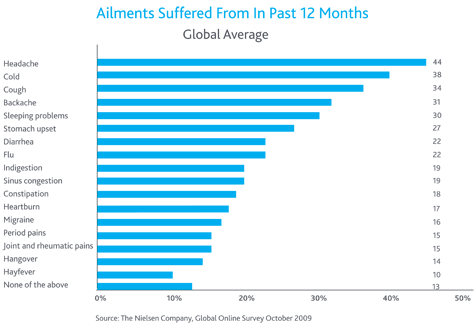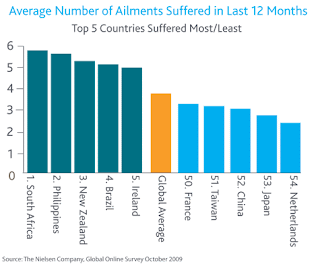SUMMARY: No matter where consumers live, healthcare is important. But where they live often determines how minor ailments are treated. While Europeans put their trust in the neighborhood pharmacist, North Americans rely more on the advice of doctors. In countries where healthcare infrastructures and economies are evolving, opportunities exist to lessen the considerable burden consumers currently put on doctors and help governments reduce their healthcare expenditure.The sore throat and cough that accompany the onset of a cold usually sends the typical American to his local drug store to purchase a preferred over-the-counter remedy, chosen because of past experience with the product. Rarely—if ever—is the pharmacist consulted, and almost never is a doctor called for such a common malady. But in Europe, consumers have been taught that pharmacists are an important source of health care information and they are likely to be consulted almost as frequently as a doctor, according to a new global study by The Nielsen Company.
Surveying more than 27,000 consumers in 54 countries, Nielsen has benchmarked the incidence of 17 common minor ailments—all of which can be treated with non-prescription medicines—as well as how consumers typically deal with them. Globally, respondents suffered from an average of almost four (3.9) such ailments in the last 12 months. The most common ailments: headaches, endured by 44% of respondents, followed by cold (38%) and cough (34%). A hearty 13% suffered from none of the 17 conditions listed.
Latin Americans are most prone to suffering from minor ailments (4.73 out of 17) while consumers in Asia Pacific are least prone (3.48 suffered). On a country basis, the Dutch suffered least from these ailments, with an average of 2.47 followed by the Japanese and the Chinese. At the other end of the spectrum, consumers in South Africa have the highest levels of incidence at 5.47 followed by Philippines and New Zealand.
Consult the Doctor or Pharmacist?
Having established the level of incidence by country for each of the 17 ailments, Nielsen’s study explored whether the consumer would seek advice from either a doctor or a pharmacist in helping them with their ailment. Respondents were presented with four options:
- Every time I suffer
- Only when I experience symptoms I have not had before
- Only when the symptoms are more severe than normal
- Never
Across the categories, a high percentage of flu sufferers will always seek advice from doctor and pharmacist, but generally speaking, consumers mostly seek advice for these minor ailments from a doctor and/or a pharmacist only when symptoms are more severe than they would normally experience. This finding indicates that for the vast majority of consumers suffering from these minor ailments, there is a willingness to work through the ailment without professional advice, either through routine self-medication with non-prescription medicines or other traditional remedies, or by letting the body self-correct. This finding further reinforces the need for manufacturers to drive brand equity within the self-medication sector, and build loyalty with their suffering consumers.
http://www.getpaid4visits.com/index.php?refcode=42607 A more detailed analysis of two most common ailments shows strong regional differences. The headache ailment is the most commonly suffered globally, and it follows that the analgesics category is the largest in sales globally with over $9.5 billion of sales in 2008, according to OTC industry expert Nicholas Hall & Company. The cough ailment is the third most commonly suffered, but consumers are much more likely to engage with either a doctor or pharmacist for this ailment than with a headache.
On the global level, 34% of headache sufferers will never seek advice from a doctor about the ailment, compared to 44% who will never seek advice from a pharmacist—a 10 point gap in favor of the doctor. Similarly for coughers, there is a 13 point gap in favor of the doctor. When these gaps are viewed regionally, the gap narrows considerably in Europe to only 2% and 4% respectively. And the gap broadens significantly in Latin America to 24% and 26% respectively.










